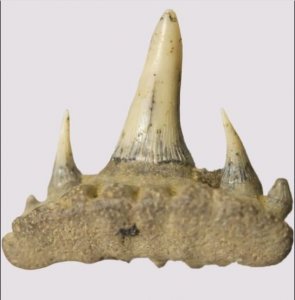
GLICKMAN'S COLLECTION
The collection of fossil remnants of cartilaginous fishesformed by the prominent soviet paleichthyologist Leonid GlickmanThe collection of remnants of the fossil cartilaginous fishes was formed by the famous soviet paleichthyologist Leonid Glickman (1929-2000). It includes tens of thousands of scientific items displaying the development if this group from the Carboniferous period until the present time. The collection mainly consists of fossil teeth of ancient sharks, rays, and Holocephali. It also includes the remnants of Teleostei, teeth and fragments of bones of sea reptiles, as well as other remnants of different invertebrates such as sponges, gastropods, bivalves, brachiopods, and echinoderms. Most of the material includes the Cretaceous (over 1000 items) and Cenozoic (over 500 items from the Paleogene period) groups of the Lamniformes.Excluding the small Carboniferous collections, the collection presents the materials from the late Jurassic period until modern times almost without any stratigraphic breaks, namely from the late Jurassic period, early Cretaceous (excluding the Berriasian), from all ages of late Cretaceous, the Paleogene, the Neogene and the Quaternary Period (including the Holocene).In 1982 the collection was donated to the State Darwin Museum by the candidate of biology N.N. Kalandadze, the senior researcher at the Orlov Paleontological Museum, a part of the Paleontological Institute of Russian Academy of Sciences. This collection has great scientific and cultural value. It is known that it took Glickman about 40 years to collect most items, which he did himself (starting from the late 1940s until the 1980s). The entire collection includes the smaller ones formed by other geologists and paleontologists: V.I. Zhelezko, V.V. Menner, A.C. Stoliarov, V.A. Bronevoy, R.G. Garetskiy, N.E. Melnikova, D.V. Obruchev, and others. There are also materials with old labels gathered by A.S. Rogovich (the 1850s), I.F. Sintsov (the 1870s) and a unique collection of fossil shark teeth found during scientific research in the Pacific and Indian oceans (RV “Vityaz”, “Ob” and “Lomonosov”).The collection of Leonid Glickman is world-famous and still remains a unique resource of information on ancient sharks for many scientists and researchers. These materials have been available for study since 2014. Many specialists in paleichthyology from various parts of Russia regularly visit the State Darwin Museum to study this collection: E.V. Popov and A.V. Biriukov (Saratov), specialists in cartilaginous fishes of the Cretaceous period, T.P. Malyshkina (Yekaterinburg), specializing in Paleogene sharks of Kazakhstan, F.A. Trikolidi (Saint Petersburg), specializing in ancient sharks of Crimea.Today, the primary processing and cataloging of samples of the Late Cretaceous period are almost completed. The largest part includes the extensive material from the Saratov region (about 36400 items). The collection includes materials from different parts of European Russia, Crimea, Kazakhstan, Uzbekistan, Turkmenistan, Ukraine, Moldova, Lithuania, and Germany. The database currently contains information and images of 39 500 shark teeth of the Cenomanian period.For more information please contact the keeper and the author of the article Eugenia Baykina.
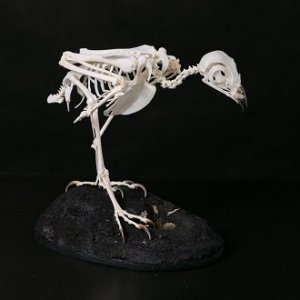
COLLECTIONS ACCESS RULES
Access to collections can be provided only with the concent of the State Darwin museum director upon the receipt of a written official request:- Scientists/researchers should provide an official request letter from an organization/institute they work for;- Students should provide an official request letter from the Yniversity they study in, containing information on their scientific curator;- Individuals may submit a formal letter addressed to the State Darwin museum director.Dr. Anna Klyukina, director of the State Darwin museumThe official request for the access to Darwin museum collections should contain information on the applicant's Last and First names, official job and occupation, purpose of research, topic and time frame, as well as a statement explaining the need to work with particular museum specimens.The formal request must contain your passport details (date and place of birth, passport number, date of issure and the authorities that issued passport), as well as your contact phone number.The permission to access museum collections will be granted after the formal letter is viewed by the museum's director and the items in question are regarded as available by the Chief conservator;The period for which the permission will be granted will be determined by the museum's director depending on the topic and the amount of work, but not more than one calendar year with the right to review and change of the period by the museum's administration.Should the research exceed the term of one calendar year or shoud the topic change, the researcher/student/individual must submit another written official request.All applicants upon the receipt of the permission get familiar with the museum working hours for visitors as well as rules of working with museum objects. A curator will be assigned to every researcher/student/individual to help organize the work in the most effient way. In case any damage or flaw to a museum object is detected, the researcher/student/individual is to inform the curator of the collection.The museum objects are not allowed to be brought anywhere outside the museum premises.When using museum objects and documents in reserch work, the researcher/student/individual should state their provenance with reference to the State Darwin museum, as well as to provide an author's copy free of charge to the museum upon the publication of work.Video-, tele- and photo shooting and photocopying of museum objects/materials is subject to prior written consent of Darwin museum administration and may be charged according to the museum's price list.
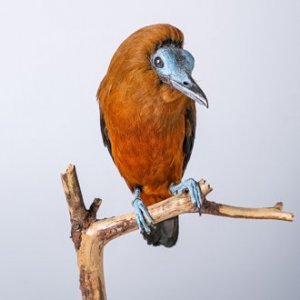
FOR PROFESSIONAL USE
SDM Electronic Archive →
Birds collection base →
Mammals collection base →
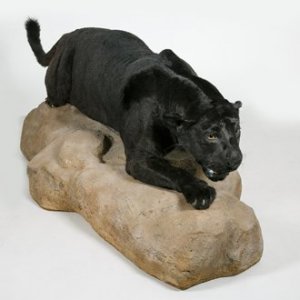
HISTORY OF COLLECTIONS
Since the very beginning, in 1907, the State Darwin Museum was planned as a museum dedicated to the theory of evolution. Thus all main collections were formed to translate this idea, unlike the majority of natural science museums - collections were arranged in such a way that allowed to show the natural variability of animals (individual or geographical) and to demonstrate the most important fundamental principles of Charles Darwin’ Theory of Evolution.Quite an extensive part of Darwin museum collection consists of specimens (mostly taxidermied birds) gathered by the founder and the first director of the museum Alexander Kohts during his student years. The materials were regularly purchased on special markets where most hunters from all over European Russia and Siberia brought their trophies. Some of the exhibits were made by Kohts himself during his two expeditions to the southern Siberia in 1899 and 1902. Another large part of taxidermy mounts is the heritage of Friedrich Lorenz's (1842 - 1909) taxidermic laboratory the best in Moscow in the late 19th century. It was the place where Kohts learned the art of taxidermy and from where many talented and skillful taxidermists came to join the State Darwin Museum.Some zoological exhibits were purchased at the beginning of 19th century from famous European taxidermy companies, such as the companies of Ward, Gardner, Rosenberg (London, England), Schlüter, Umlauf (Halle and Hamburg, Germany), and Fritsch (Prague, Austria-Hungary, now the Czech Republic). Some materials were donated by the members of the expeditions to various regions of eastern Africa - Vladimir Troitskiy and Vasily Nikitin - as well as from private museums and collections nationalized after the revolution of 1917.Since the mid-80-es regular expedition activities for collecting scientific materials were initiated by a new generation of young and talented employees of the Darwin museum. Ornithological, entomological, and malacological collections were formed especially intensively, according to scientific interests and specialization of researchers.When studying and processing the museum's fund collections, the museum’s staff prepared and published a large number of scientific works on the zoogeography and taxonomy of the studied groups of animals. These publications describe thirty new species and subspecies of diurnal butterflies and beetles. The State Darwin Museum continually keeps studying and developing its extensive and precious natural history and art collections.One of the most important collections of Darwin museum is the one of Lyrurus with color variations. Part of it is the heritage of Friedrich Lorenz's taxidermic laboratory, some were bought from hunters on the special market, six birds were donated by The Polytechnic Museum. Alexander Kohts traded some exhibits for the collection of such birds of V. Andreevsky, collected in mid 19th century and which belonged to St. Petersburg University. A few years earlier the regional natural history museum of Yekaterinburg donated a collection of Lyrurus with color variations and their hybrids. Today this collection comprises over 600 specimens and is frequently replenished.One of the unique exhibits of Darwin Museum collection of birds is the taxidermied great auk (Pinguinus impennis) - a species of extinct flightless alcid that used to inhabit islands in the North Atlantic – as well as several taxidermied extinct passenger pigeons, which once used to be one of the most common birds in North America. Another most valuable specimen is the skeleton of the dodo (Raphus cucullatus) - an extinct flightless bird that was endemic to the island of Mauritius, east of Madagascar in the Indian Ocean.The Museum’s collection of birds was replenished with donations from private collectors, as well as scientific expeditions of the Museum’s employees. For example, Darwin museum’s collection of birds 167 nests and 661 eggs used to belong to a private collector and was donated to the museum by his relatives after the owner had passed away.Darwin museum is also proud of its collection of the birds-of-paradise, comprising 178 specimens. It is considered as the best in Russia. The Hummingbirds is also one of the best in Russia and consists of 558 taxidermied birds. Most of the taxidermied mammals were also inherited from the Friedrich Lorenz's taxidermic laboratory. The materials for taxidermy mounts were bought from hunters or on the special market.Since 1917 a great number of animal furs with color variations were frequently supplied by Soyuzpushnina – a State Fur Auction, where such furs were considered as faulty goods while being highly valued by the Museum. Alexander Kohts gave a couple of lectures for the Soyuzpushnina’s employees, mainly to explain his interest in such materials and educate the workers about its scientific value. Today this collection comprises 178 taxidermied mounts and 149 furs. The mentioned cooperation lasted until 1984. One of the most valuable parts of the Entomology collection is the collection of butterflies. It includes the precious specimens of butterflies collected on a New Guinea by a renowned English bird collector and naturalist Albert Stewart Meek, as well as in French Guiana by Eugène Le Moult, a French naturalist and entomologist specialised in butterflies. All specimens are well preserved and labeled. In the 1970s a private collection of about 500 butterflies collected in the Far East, Zabaykalsky Krai, and Soviet Central Asia was donated to Darwin museum. In 2004 the museum’s collection was replenished by a private one containing over 2 500 specimens of Swallowtail butterflies.Museum has always been working on Entomology collection replenishment, buying from collectors and naturalists, attempting to gather various species in order to make it the most complete. From the very beginning the founders of Darwin museum were working on forming a collection of Fine Arts, comprising paintings, drawings, and sculptures. Alexander Kohts worked with some of the best Russian animalist artists, who later became the museum’s employees and formed a school of contemporary animalistic art in Russia. These artworks were to accompany the exhibition and to illustrate the life of the taxidermied animals in the wild.Today the collection is regularly being replenished with the works by modern animalist artists. The Rare Books collection contains such precious books as “Historia animalium” by Conrad Gessner, twelve volumes by Ulisse Aldrovandi, numerous editions of Charles Darwin’s works published during his life and translated into different languages. Many of these books were bought during the trip to Europe in 1913 of the Darwin museum founders – Alexander Kohts and his spouse Nadezhda Ladygina-Kohts.The collection was often replenished by private collections of museum employees and renowned Russian biologists, therefore it contains editions published before 1914, as well as some other rare books. In 1982, Darwin museum bought the collection of remnants of the fossil cartilaginous fishes and sharks that belonged to a paleichthyologist Leonid Glickman. This collection comprises over 112 000 specimens gathered in various regions of the USSR and in territorial waters of the USSR in the Pacific ocean. It took him more than 20 years to form the collection. The collection is of great scientific value as it contains typical specimens on recently determined species as well as stratigraphic completeness. A significant part of mollusc collection – 7 479 specimens – were donated to Darwin museum by a visually impaired private collector Konstantin Gaydenko in the 1980s. Most of the specimens are tropical species and were obtained via exchange with collectors from abroad. Some of the specimens are of great scientific value as they are very rare and often poorly represented in museums and private collections around the world. Today the collection is regularly being replenished.
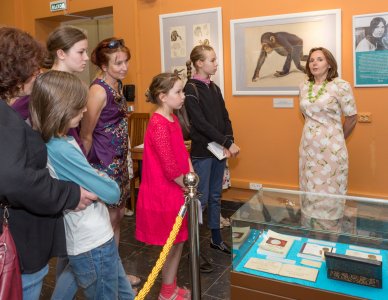
TOURING EXHIBITIONS
Are animals as clever as we are?Are animals as clever as we are? This question has got not only scientists intrigued. This exhibition unravels the mystery behind experiments on animals within the research of their intellectual abilities.Visitors will get an idea of whether mammals, birds and insects are smart. How big is the gap between animals’ and humans in terms of the abilities of their mind/brain. Observation of animals’ behaviour in the wild sometimes doesn’t provide sufficient data, which can be obtained with the help of scientific experiments set with regard to particular circumstances and environment.The selected experiments remind school program. Animals are tested to learn how to calculate (add up) and recognize geometric shapes, to see whether they have good or poor spatial awareness, whether they are able to construct sentences and build something using their paws, beaks, if they can draw, and finally misbehave like children do during breaks at school. Many of these tasks animals complete as well as or even better than we do.25 panels 1x1 mExhibition program:A quiz, folding instructions for Origami, a labyrinth, a jigsaw puzzle, a test “An artist or a monkey?”Multimedia:a program “The language of vervet monkeys”, slide show “Paintings and drawings of primates making and/or using tools”, a game “IQ of different animals”












